Potential Role of Fertilizer Sources and Soil Tillage Practices to Mitigate Soil CO2 Emissions in Mediterranean Potato Production Systems
Abstract
1. Introduction
2. Materials and Methods
2.1. Study Site and Soil Characteristics
2.2. Experimental Design
2.3. Field Setup and Crop Management
2.4. Data Collection and Analysis
2.5. Statistical Analysis
3. Results
3.1. Weather Conditions during Potato Growing Seasons
3.2. Soil CO2 Emissions, Temperature and Volumetric Water Content during the Potato Growing Season
3.2.1. Effect of Fertilizer Sources
3.2.2. Effect of Soil Tillage Management
3.3. Potato Yield and Agro-Ecosystem Carbon Balance
4. Discussion
5. Conclusions
Author Contributions
Funding
Conflicts of Interest
References
- Krištof, K.; Šima, T.; Nozdrovický, L.; Findura, P. The effect of soil tillage intensity on carbon dioxide emissions released from soil into the atmosphere. Agron. Res. 2014, 12, 115–120. [Google Scholar]
- Lal, R. Soil carbon sequestration to mitigate climate change. Geoderma 2004, 123, 1–22. [Google Scholar] [CrossRef]
- Bhardwaj, A.K.; Jasrotia, P.; Hamilton, S.K.; Robertson, G.P. Ecological management of intensively cropped agro-ecosystems improves soil quality with sustained productivity. Agric. Ecosyst. Environ. 2011, 140, 419–429. [Google Scholar] [CrossRef]
- Abdalla, K.; Chivenge, P.; Ciais, P.; Chaplot, V. No-tillage lessens soil CO2 emissions the most under arid and sandy soil conditions: Results from a meta-analysis. Biogeosciences 2016, 13, 3619–3633. [Google Scholar] [CrossRef]
- Vieira, F.C.B.; Bayer, C.; Zanatta, J.A.; Mielniczuk, J.; Six, J. Building Up Organic Matter in a Subtropical Paleudult under Legume Cover-Crop-Based Rotations. Soil Sci. Soc. Am. J. 2009, 73, 1699–1706. [Google Scholar] [CrossRef]
- So, H.B.; Dalal, R.C.; Chan, K.Y.; Menzies, N.M.; Freebairn, D.M. Potential of Conservation Tillage to Reduce Carbon Dioxide Emission in Australian Soils. In Proceedings of the 10th International Soil Conservation Organization Meeting, West Lafayette, IN, USA, 24–29 May 1999; pp. 821–826. [Google Scholar]
- Barré, P.; Eglin, T.; Christensen, B.T.; Ciais, P.; Houot, S.; Kätterer, T.; Van Oort, F.; Peylin, P.; Poulton, P.R.; Romanenkov, V.; et al. Quantifying and isolating stable soil organic carbon using long-term bare fallow experiments. Biogeosciences 2010, 7, 3839–3850. [Google Scholar] [CrossRef]
- Carter, M.R.; Sanderson, J.B.; Holmstrom, D.A.; Ivany, J.A.; DeHaan, K.R. Influence of conservation tillage and glyphosate on soil structure and organic carbon fractions through the cycle of a 3-year potato rotation in Atlantic Canada. Soil Tillage Res. 2007, 93, 206–221. [Google Scholar] [CrossRef]
- Campiglia, E.; Mancinelli, R.; De Stefanis, E.; Pucciarmati, S.; Radicetti, E. The long-term effects of conventional and organic cropping systems, tillage managements and weather conditions on yield and grain quality of durum wheat (Triticum durum Desf.) in the Mediterranean environment of Central Italy. Field Crop. Res. 2015, 176, 34–44. [Google Scholar] [CrossRef]
- Radicetti, E.; Campiglia, E.; Marucci, A.; Mancinelli, R. How winter cover crops and tillage intensities affect nitrogen availability in eggplant. Nutr. Cycl. Agroecosystems 2017, 108, 177–194. [Google Scholar] [CrossRef]
- Santos, N.Z.D.; Dieckow, J.; Bayer, C.; Molin, R.; Favaretto, N.; Pauletti, V.; Piva, J.T. Forages, cover crops and related shoot and root additions in no-till rotations to C sequestration in a subtropical Ferralsol. Soil Tillage Res. 2011, 111, 208–218. [Google Scholar] [CrossRef]
- Hernández, T.; Chocano, C.; Moreno, J.L.; García, C. Towards a more sustainable fertilization: Combined use of compost and inorganic fertilization for tomato cultivation. Agric. Ecosyst. Environ. 2014, 196, 178–184. [Google Scholar] [CrossRef]
- Hargreaves, J.C.; Adl, M.S.; Warman, P.R. A review of the use of composted municipal solid waste in agriculture. Agric. Ecosyst. Environ. 2008, 123, 1–14. [Google Scholar] [CrossRef]
- Tejada, M.; Hernandez, M.T.; Garcia, C. Soil restoration using composted plant residues: Effects on soil properties. Soil Tillage Res. 2009, 102, 109–117. [Google Scholar] [CrossRef]
- Siddiqui, Y.; Islam, T.M.; Naidu, Y.; Meon, S. The conjunctive use of compost tea and inorganic fertiliser on the growth, yield and terpenoid content of Centella asiatica (L.) urban. Sci. Hortic. (Amsterdam). 2011, 130, 289–295. [Google Scholar] [CrossRef]
- Adewale, C.; Reganold, J.P.; Higgins, S.; Evans, R.D.; Carpenter-Boggs, L. Improving carbon footprinting of agricultural systems: Boundaries, tiers, and organic farming. Environ. Impact Assess. Rev. 2018, 71, 41–48. [Google Scholar] [CrossRef]
- Carter, M.R.; Sanderson, J.B. Influence of conservation tillage and rotation length on potato productivity, tuber disease and soil quality parameters on a fine sandy loam in eastern Canada. Soil Tillage Res. 2001, 63, 1–13. [Google Scholar] [CrossRef]
- Soil Survey Staff. Keys to Soil Taxonomy, 11th ed.; United States Department of Agriculture, Natural Resources Conservation Service: Washington, DC, USA, 2010.
- Campiglia, E.; Paolini, R.; Colla, G.; Mancinelli, R. The effects of cover cropping on yield and weed control of potato in a transitional system. Field Crop. Res. 2009, 112, 16–23. [Google Scholar] [CrossRef]
- Pumpanen, J.; Kolari, P.; Ilvesniemi, H.; Minkkinen, K.; Vesala, T.; Niinistö, S.; Lohila, A.; Larmola, T.; Morero, M.; Pihlatie, M.; et al. Comparison of different chamber techniques for measuring soil CO2 efflux. Agric. For. Meteorol. 2004, 123, 159–176. [Google Scholar] [CrossRef]
- Radicetti, E.; Campiglia, E.; Langeroodi, A.S.; Zsembeli, J.; Mendler-Drienyovszki, N.; Mancinelli, R. Soil carbon dioxide emissions in eggplants based on cover crop residue management. Nutr. Cycl. Agroecosystems 2020, 118, 39–55. [Google Scholar] [CrossRef]
- Radicetti, E.; Osipitan, O.A.; Reza, A.; Langeroodi, S.; Marinari, S.; Mancinelli, R. CO2 Flux and C Balance due to the Replacement of Bare Soil with Agro-Ecological Service Crops in Mediterranean Environment. Agriculture 2019, 9, 71. [Google Scholar] [CrossRef]
- Adviento-Borbe, M.A.A.; Haddix, M.L.; Binder, D.L.; Walters, D.T.; Dobermann, A. Soil greenhouse gas fluxes and global warming potential in four high-yielding maize systems. Glob. Chang. Biol. 2007, 13, 1972–1988. [Google Scholar] [CrossRef]
- Mancinelli, R.; Campiglia, E.; Di Tizio, A.; Marinari, S. Soil carbon dioxide emission and carbon content as affected by conventional and organic cropping systems in Mediterranean environment. Appl. Soil Ecol. 2010, 46, 64–72. [Google Scholar] [CrossRef]
- Littell, R.C.; Milliken, G.A.; Stroup, W.W.; Wolfinger, R.D. SAS System for Mixed Models; SAS Publishing: Cary, NC, USA, 1996; ISBN 1555447791. [Google Scholar]
- Gomez, K.A.; Gomez, A.A. Statistical Procedures for Agricultural Research; Wiley-Interscience: Hoboken, NJ, USA, 1984. [Google Scholar]
- Papp, R.; Marinari, S.; Moscatelli, M.C.; van der Heijden, M.G.A.; Wittwer, R.; Campiglia, E.; Radicetti, E.; Mancinelli, R.; Fradgley, N.; Pearce, B.; et al. Short-term changes in soil biochemical properties as affected by subsidiary crop cultivation in four European pedo-climatic zones. Soil Tillage Res. 2018, 180, 126–136. [Google Scholar] [CrossRef]
- Langeroodi, A.S.; Adewale Osipitan, O.; Radicetti, E. Benefits of sustainable management practices on mitigating greenhouse gas emissions in soybean crop (Glycine max). Sci. Total Environ. 2019, 660, 1593–1601. [Google Scholar] [CrossRef] [PubMed]
- Mancinelli, R.; Marinari, S.; Brunetti, P.; Radicetti, E.; Campiglia, E. Organic mulching, irrigation and fertilization affect soil CO2 emission and C storage in tomato crop in the Mediterranean environment. Soil Tillage Res. 2015, 152, 39–51. [Google Scholar] [CrossRef]
- Carter, M.R.; Noronha, C.; Peters, R.D.; Kimpinski, J. Influence of conservation tillage and crop rotation on the resilience of an intensive long-term potato cropping system: Restoration of soil biological properties after the potato phase. Agric. Ecosyst. Environ. 2009, 133, 32–39. [Google Scholar] [CrossRef]
- Mundy, C.; Creamer, N.G.; Crozier, C.R.; Wilson, L.G.; Morse, R.D. Soil physical properties and potato yield in no-till, subsurface-till, and conventional-till systems. Horttechnology 1999, 9, 240–247. [Google Scholar] [CrossRef]
- Giordano, D.M.; Facchinetti, D.; Pessina, D. The spading machine as an alternative to the plough for the primary tillage. J. Agric. Eng. 2015, 46, 36–40. [Google Scholar] [CrossRef]
- Laudicina, V.A.; Palazzolo, E.; Catania, P.; Vallone, M.; García, A.D.; Badalucco, L. Soil Quality Indicators as Affected by Shallow Tillage in a Vineyard Grown in a Semiarid Mediterranean Environment. Land Degrad. Dev. 2017, 28, 1038–1046. [Google Scholar] [CrossRef]
- Usaborisut, P.; Prasertkan, K. Specific energy requirements and soil pulverization of a combined tillage implement. Heliyon 2019, 5, e02757. [Google Scholar] [CrossRef]
- Fox, J.W.; Khalilian, A.; Han, Y.J.; Williams, P.B.; Nafchi, A.M.; Maja, J.M.; Marshall, M.W.; Barnes, E.M. Real-Time, Variable-Depth Tillage for Managing Soil Compaction in Cotton Production. Open J. Soil Sci. 2018, 8, 147–161. [Google Scholar] [CrossRef]
- Nyawade, S.O.; Karanja, N.N.; Gachene, C.K.K.; Schulte-Geldermann, E.; Parker, M. Effect of potato hilling on soil temperature, soil moisture distribution and sediment yield on a sloping terrain. Soil Tillage Res. 2018, 184, 24–36. [Google Scholar] [CrossRef]
- Rens, L.R.; Zotarelli, L.; Rowland, D.L.; Morgan, K.T. Optimizing nitrogen fertilizer rates and time of application for potatoes under seepage irrigation. Field Crop. Res. 2018, 215, 49–58. [Google Scholar] [CrossRef]
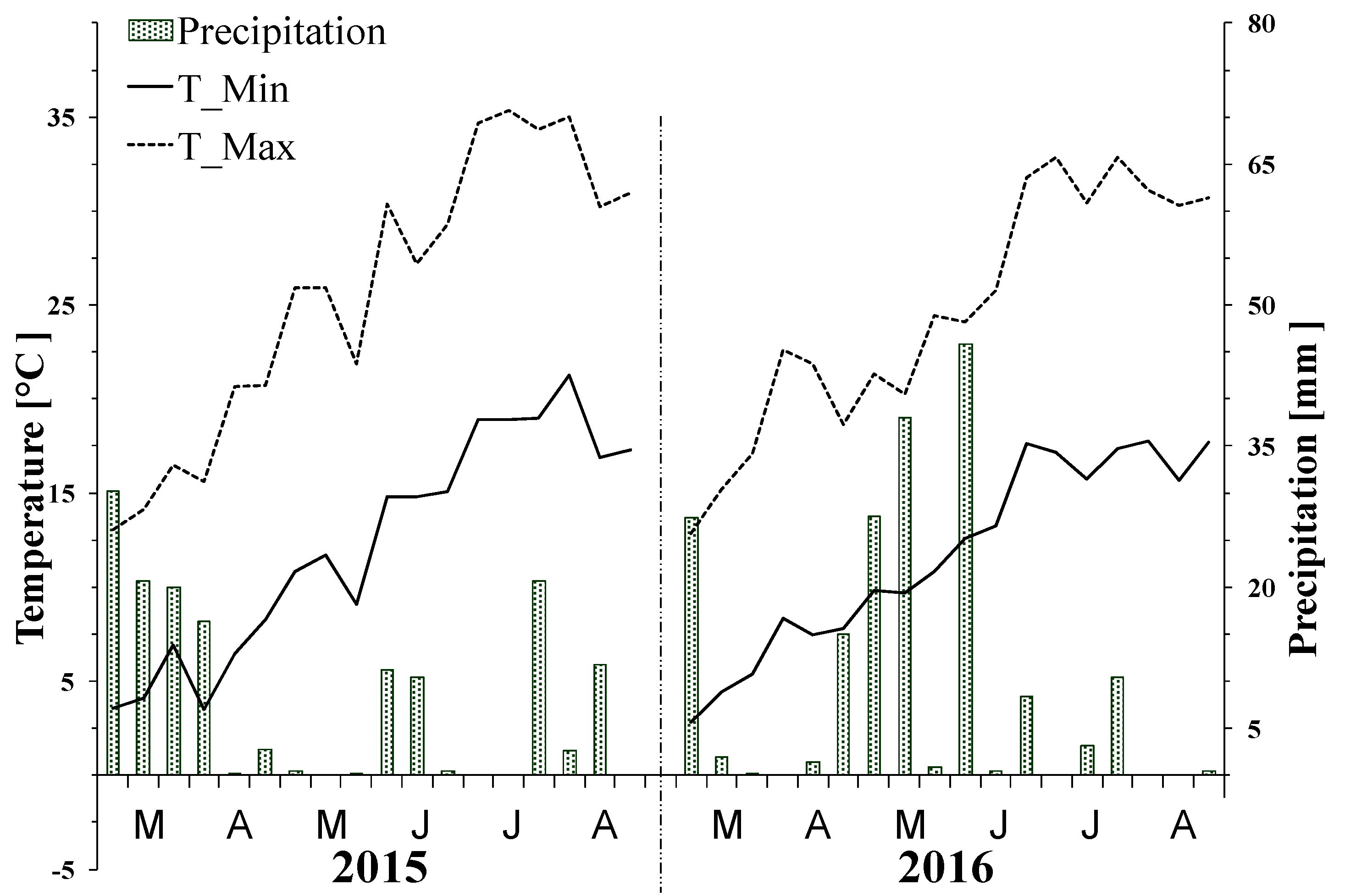
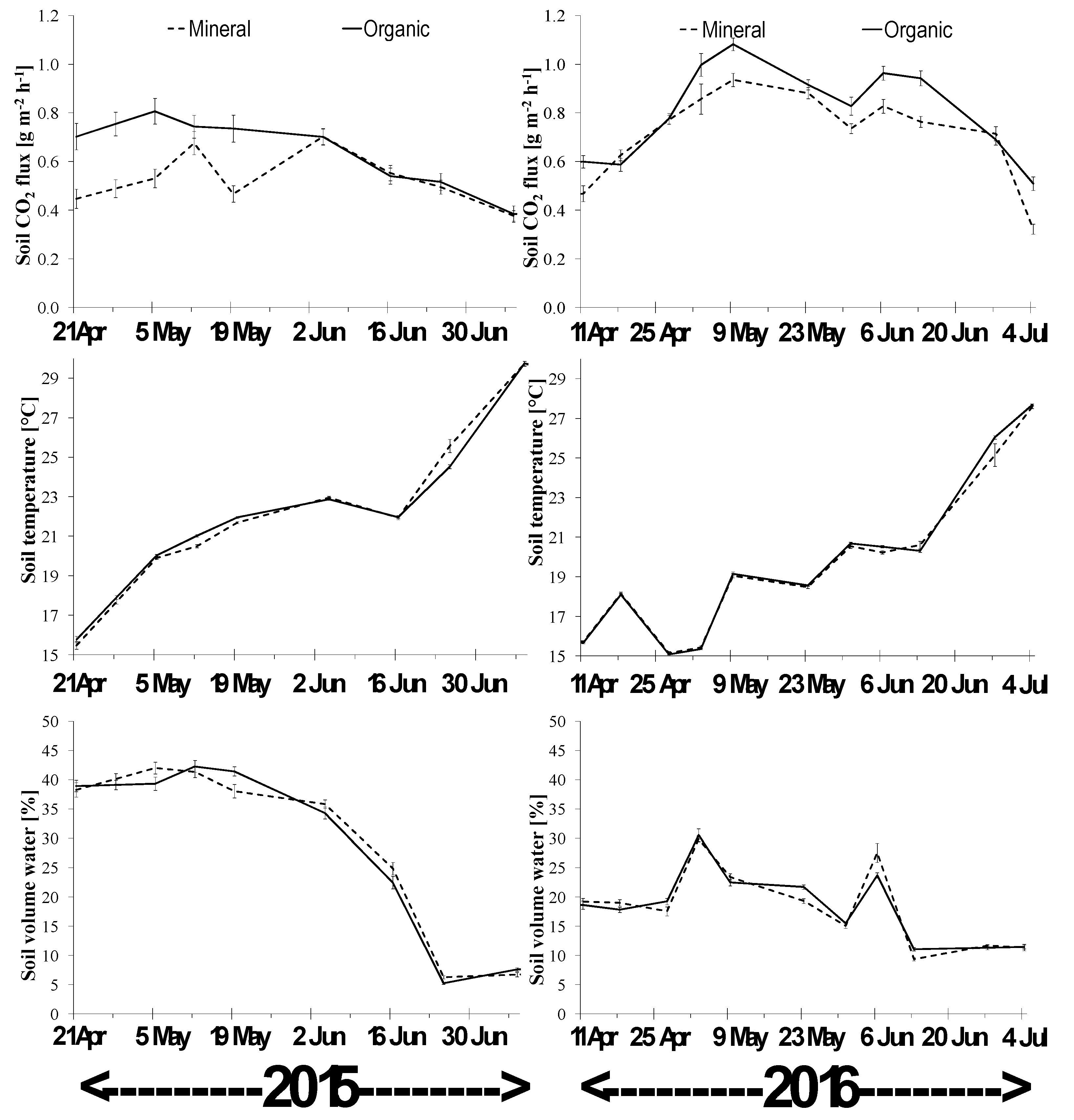
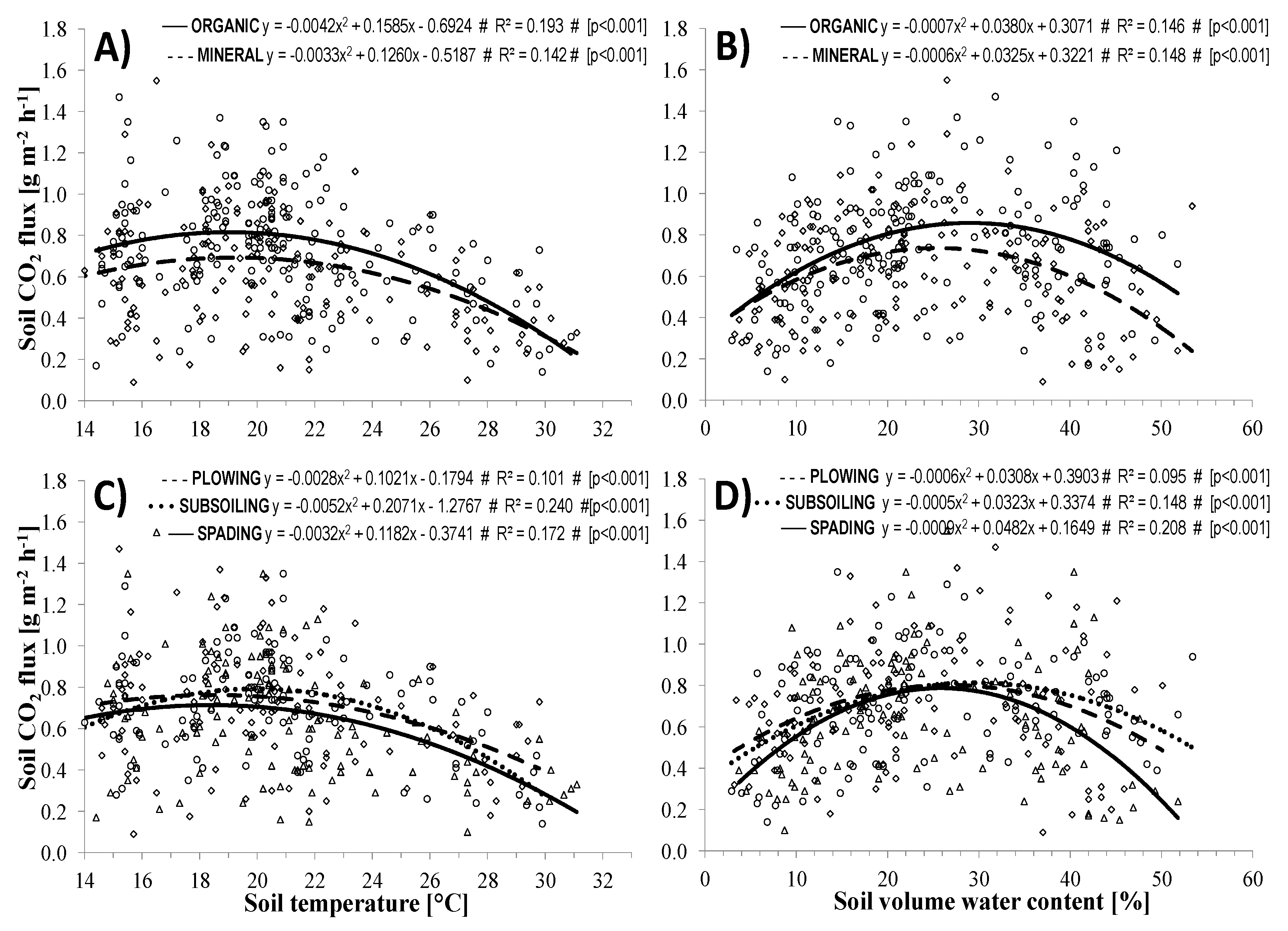
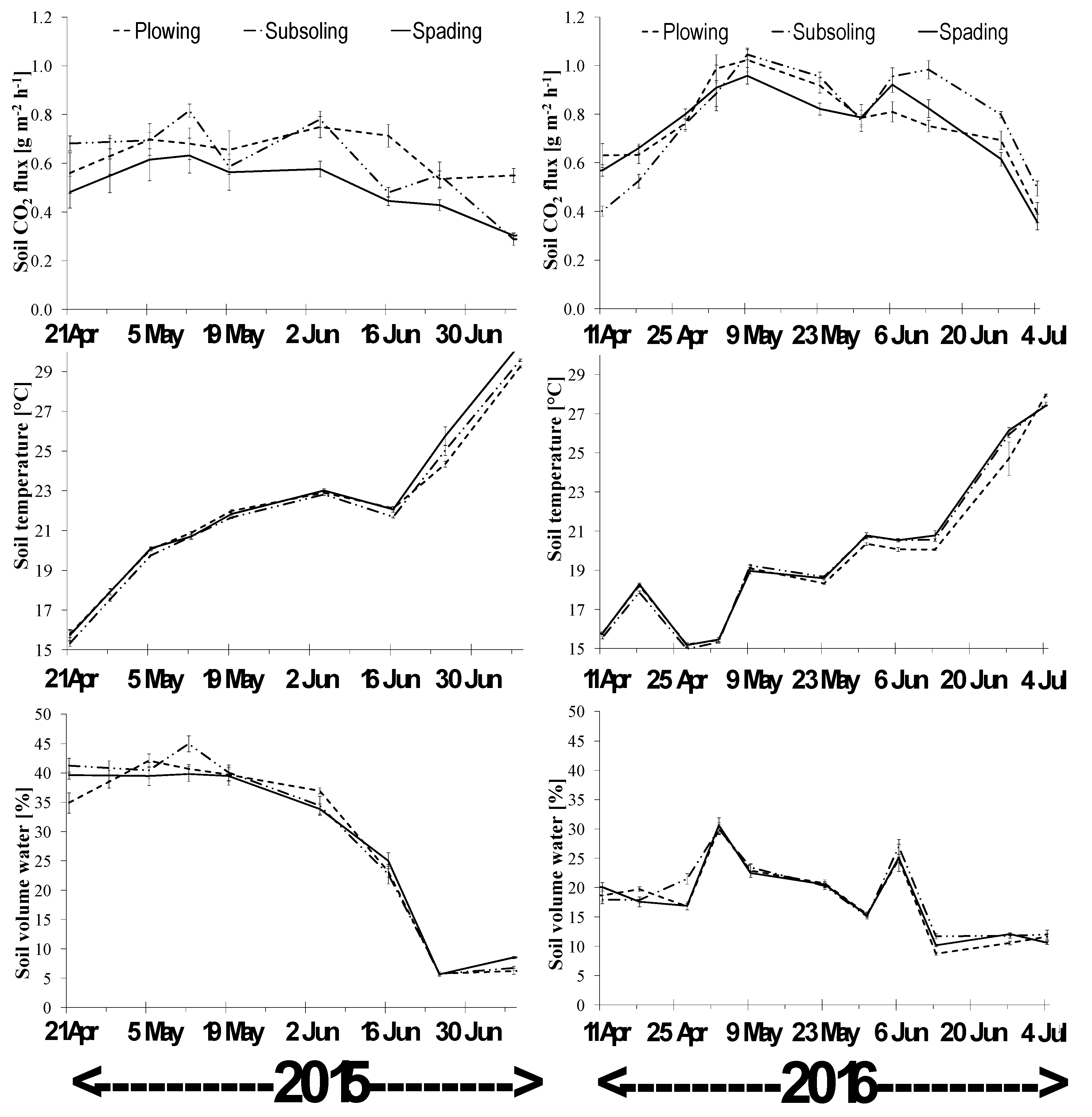
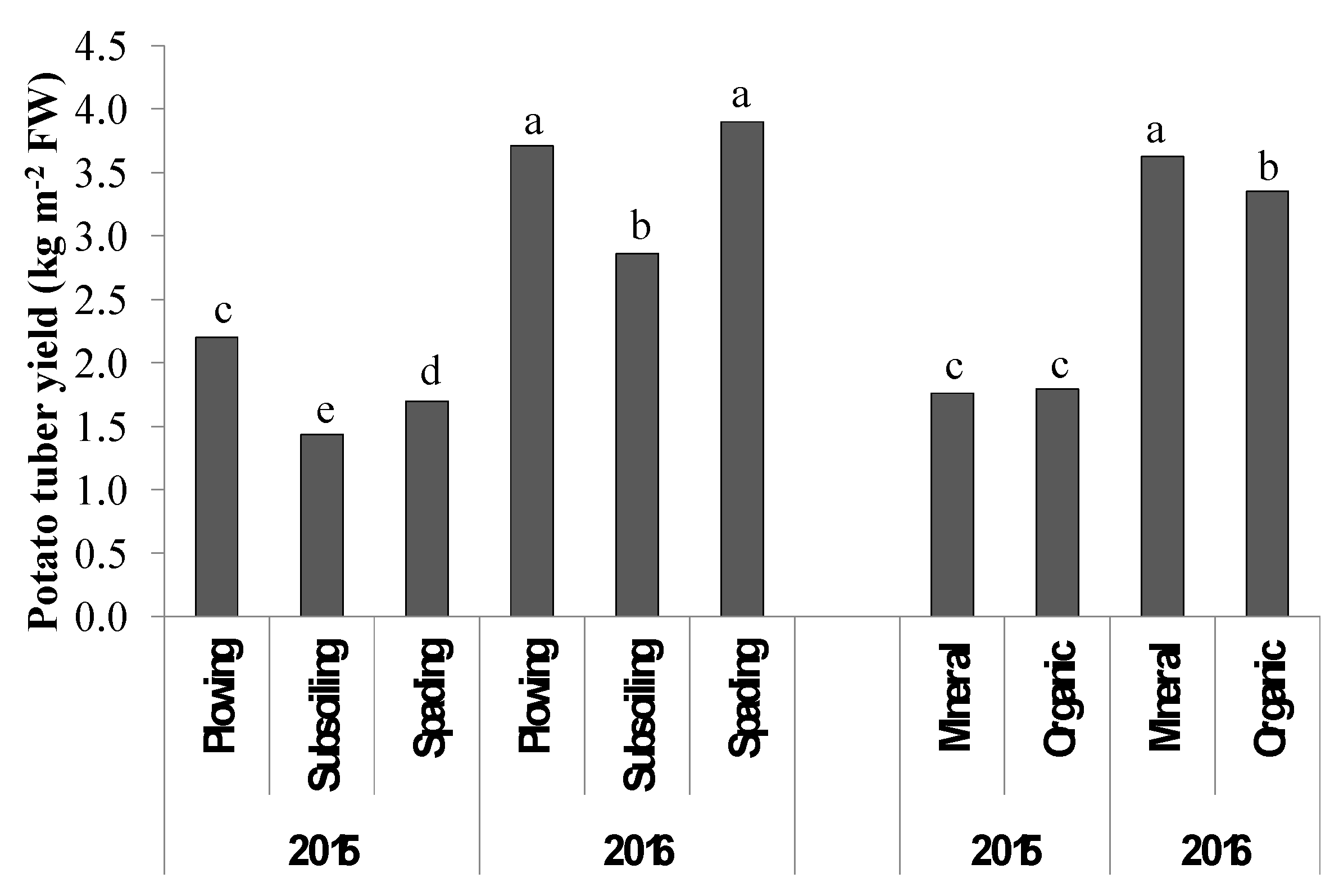
| C-Input by Biomasses (Mg C ha−1) | C Output by CO2 Emission (Mg C ha−1) | C Input/C Output | CO2 Emission/Yield | |
|---|---|---|---|---|
| Soil tillage | ||||
| Plowing | 4.76 a | 3.85 a | 1.24 ab | 0.59 b |
| Subsoiling | 4.40 b | 3.91 a | 1.12 b | 0.89 a |
| Spading | 4.32 b | 3.45 b | 1.25 a | 0.57 b |
| Fertilizer source | ||||
| Mineral | 3.40 b | 3.51 b | 0.97 b | 0.75 a |
| Organic | 5.59 a | 3.97 a | 1.41 a | 0.62 b |
| Year | ||||
| 2015 | 4.35 b | 3.08 b | 1.41 a | 0.57 b |
| 2016 | 4.63 a | 4.39 a | 1.05 b | 0.80 a |
Publisher’s Note: MDPI stays neutral with regard to jurisdictional claims in published maps and institutional affiliations. |
© 2020 by the authors. Licensee MDPI, Basel, Switzerland. This article is an open access article distributed under the terms and conditions of the Creative Commons Attribution (CC BY) license (http://creativecommons.org/licenses/by/4.0/).
Share and Cite
Mancinelli, R.; Marinari, S.; Allam, M.; Radicetti, E. Potential Role of Fertilizer Sources and Soil Tillage Practices to Mitigate Soil CO2 Emissions in Mediterranean Potato Production Systems. Sustainability 2020, 12, 8543. https://doi.org/10.3390/su12208543
Mancinelli R, Marinari S, Allam M, Radicetti E. Potential Role of Fertilizer Sources and Soil Tillage Practices to Mitigate Soil CO2 Emissions in Mediterranean Potato Production Systems. Sustainability. 2020; 12(20):8543. https://doi.org/10.3390/su12208543
Chicago/Turabian StyleMancinelli, Roberto, Sara Marinari, Mohamed Allam, and Emanuele Radicetti. 2020. "Potential Role of Fertilizer Sources and Soil Tillage Practices to Mitigate Soil CO2 Emissions in Mediterranean Potato Production Systems" Sustainability 12, no. 20: 8543. https://doi.org/10.3390/su12208543
APA StyleMancinelli, R., Marinari, S., Allam, M., & Radicetti, E. (2020). Potential Role of Fertilizer Sources and Soil Tillage Practices to Mitigate Soil CO2 Emissions in Mediterranean Potato Production Systems. Sustainability, 12(20), 8543. https://doi.org/10.3390/su12208543








